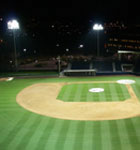backgrounder/
Founded in 1983, Qualite has made its name developing high-wattage lighting for indoor and outdoor sports venues and for applications in outdoor security and large-area lighting. The Hillsdale, Michigan-based company produces a range of lights and fixtures that provide optimal lighting, control glare and spill, and help conserve energy and reduce utility costs.
“We’ve been striving for energy efficiency since we started business and well before the more recent energy buzz,” president Nick Page says. “We’ve always tried to couple fixture efficiency with maintenance controls to help keep energy consumption down.” That commitment has led Qualite to be the first company to bring energy-saving electronic-ballast technology to the high-wattage lamp market. Until now, the technology was only available in lower wattages. “We’ve been working on it for more than 15 years,” Page says.
challenge/
It’s no secret that giant light standards at stadiums and arenas consume a lot of energy. “With bulbs from 1,000 to 2,000 watts and many fixtures per field, you can really make the meter spin,” Page says. Occasionally the user will also get hit with peak-time usage charges. So how do you lower the costs but keep the lights burning bright?
solution/
Qualite’s new Green Star Series light fixtures utilize a high-wattage electronic-ballast system to generate more lumens per watt. “What you get with electronic ballast is increased lumen output—increased lamp light—but without consuming additional energy,” Page says.

Qualite’s energy- saving lumenaires rely on its Green Star Series set-up, which uses electronic-ballast technology.
Put into real numbers, traditional magnetic ballast requires 1,625 watts to drive a 1,500 watt bulb, but electronic ballast can do the same thing with just 1,540 watts. Electronic ballast is nothing new, but the problem has been marrying the technology to high-wattage lamps. “The key is ballast robustness and dissipating the heat. We came up with a unique means of mounting the ballast that allows air flow all the way around it,” Page says. Qualite’s light fixtures have been installed in high school and college sports venues, city parks, minor league baseball stadiums, and professional-soccer facilities. “Most of our Green Star Series sites have been beta sites,” Page says. “We’ve done all the lab tests, and we’re doing the field tests now. We’re trying to keep it manageable so we can address glitches if there are any.”
The new Green Star Series light fixtures are dimmable and addressable, which means there is not the energy waste that occurs when traditional lights are used to augment late afternoon and evening sunlight. While lamps depreciate in output as soon as you start them, the Green Star lamps depreciate at a much slower rate. That translates to more uniform, reliable light throughout the lifetime of the lamp.
Page says the new lights cost more than traditional lights, and special cabling is required because the ballast is located at the base of the poles for easier maintenance. “But with the energy savings and lower maintenance, the return on investment comes back pretty quickly,” he says.
Though new venues are obvious candidates for the Green Star Series light fixtures, existing venues can be upgraded with the new technology. “We’re really going to target the retrofit market,” Page says. “There are lots of good fixtures out there, but we can replace the ‘engine’ for them.”

